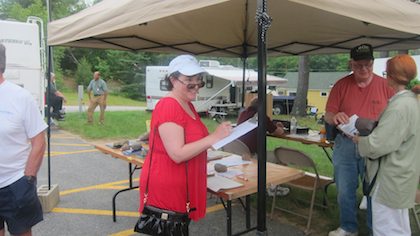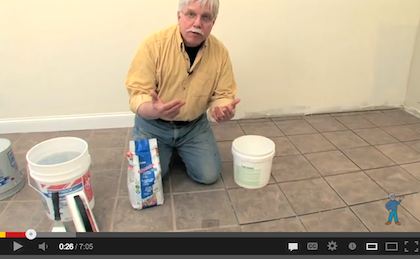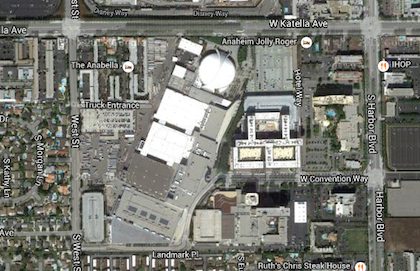June 25, 2013 AsktheBuilder Newsletter & Tips
This past weekend I basically took off and enjoyed myself.
I spent the time with my ham radio buddies at our annual Field Day. Field Day is celebrated by thousands of amateur radio clubs all across North America.
Its primary purpose is to demonstrate to the public how amateur radio operators can set up in the 'field' in the event of a disaster. It's also a contest to see how many points you can get for making radio contacts with other operators.
You can get extra points for doing other things such as an article in a local paper, having the event in a public place, etc.
I had a great time, the weather was perfect - not too hot and humid, and there was plenty of fun to be had. I suggest you read my account of the day. Believe me, it's NOT a story about radios, antennas and boring radio speak.
Here's a photo of our visitor tent where we had a Get-On-The-Air station set up. You don't have to have a license to talk on the radio at events like this. Normal citizens were able to sit down and converse with other people hundreds or thousands of miles away.
The woman in red is the Honorable Jane Cormier, a NH State Representative. You get 100 points in the contest if you get an elected official to stop by. Guess who made that happen? :->>>>
I GUARANTEE you'll have a large grin on your face after reading opens in a new windowmy story about Field Day. Feel free to share the link with your friends - especially if you know any ham radio operators.
TIP OF THE WEEK - CERAMIC FLOOR TILE GROUT
Are you thinking of installing ceramic floor tile soon? If it's larger tile, you'll be needing sanded grout. This grout is just a blend of pigmented Portland cement and fine silica sand.
The silica sand makes the grout strong, and is responsible for making it very durable. Silica has a hardness of 7. That's pretty darn hard when it comes to minerals.
But, if you don't install the grout just right, it's all for naught. The grout will crack and crumble.
opens in a new windowWatch this video series to see the right way to install Ceramic Floor Tile Grout.
TIM ON THE ROAD!
It appears there's a VERY GOOD CHANCE I'll be traveling to Anaheim, CA at the beginning of August. We'll do a meet up for sure if this trip materializes. WATCH upcoming issues to see if I lock this trip in.
ROMAN CONCRETE
Michael Lenn, a subscriber, sent me a link to a opens in a new windowfascinating article on Roman concrete.
To make a long story short, the Romans discovered a recipe to make long-lasting concrete. They mixed hydrated lime with volcanic ash and water. This made a mortar mix. When you then add chunks of larger volcanic rock, you get concrete.
You may not know this, but I'm a college-trained geologist. My buddy Phil Clymer is reading this now and grinning. Phil and I were buddies and had many a good time back in the early 1970's on geology field trips.
If the two of us could give a seminar, Phil would dominate because he pursued geology as a career. He's a petroleum geologist.
But, I believe we'd both tell you that the volcanic ash the Romans used probably had a high silica content. Remember what I said up above about the sanded grout?
The chunks of volcanic rock probably were high in silica too. Quartz is SiO2. You know how hard quartz is, right? Most granite is high in silica. That's why granite is so resistant to erosion.
Maybe this is a business opportunity! Import silica-rich volcanic ash to make concrete! Nope, shipping is no doubt far too expensive.
STORING SMALL GASOLINE ENGINES
Have you ever let loose a string of curse words when you're unable to get a small gasoline engine started? Years ago, I did.
But then I discovered the secret to having small engines start EVERY time.
Do you want to have small engine nirvana in your garage or shed? opens in a new windowRead my column on storing small engines.
PAKISTANI PILE DRIVERS
Early in the spring here in Meredith, NH, I saw a pile driver working for about a week at our Hannaford's grocery store. The store is expanding and it's near the lake. The soil is not too strong because of silt and other things that have started to fill in the lake over the years since the continental glacier melted about 15,678 years ago.
Modern machine pile drivers are lifted and held in place by cranes. Think of a giant hammer pounding nails.
But these nails are often giant steel tubes (piles) that can be 40 or 50 feet long. They can be made from precast concrete. In fact, the tubes are often welded together if the piles are being driven deep into the ground. Years ago piles were made from rot-resistant logs.
You can also drill into the ground, if the soil will not collapse as you drill, and pour concrete in the vertical space to create a pile. Trust me, pile construction is VERY complex with many different types and systems.
Piles are needed when a building is built on low-strength soil. The surface area of the sides of the piles make it so the building foundation does not sink into the weak soil. The building's footers and foundations are placed on top of piles. Think of piles the same way you think of table legs. The legs support the table.
Not everyone has access to a crane and mechanical pile driver. opens in a new windowWatch this video to see how piling driving is done in other countries. Look for the man in the center with the tambourine!
Pay attention to the long spades that are used to dig the pilot holes for these precast piles. There's lots of information in this video if you look at all the things on the construction site. For example, look at the pile of mud next to the piles. Enjoy!
P.S. Don't show this video to anyone that works for OSHA. They may collapse from a heart attack.
More tips and tricks next week!


